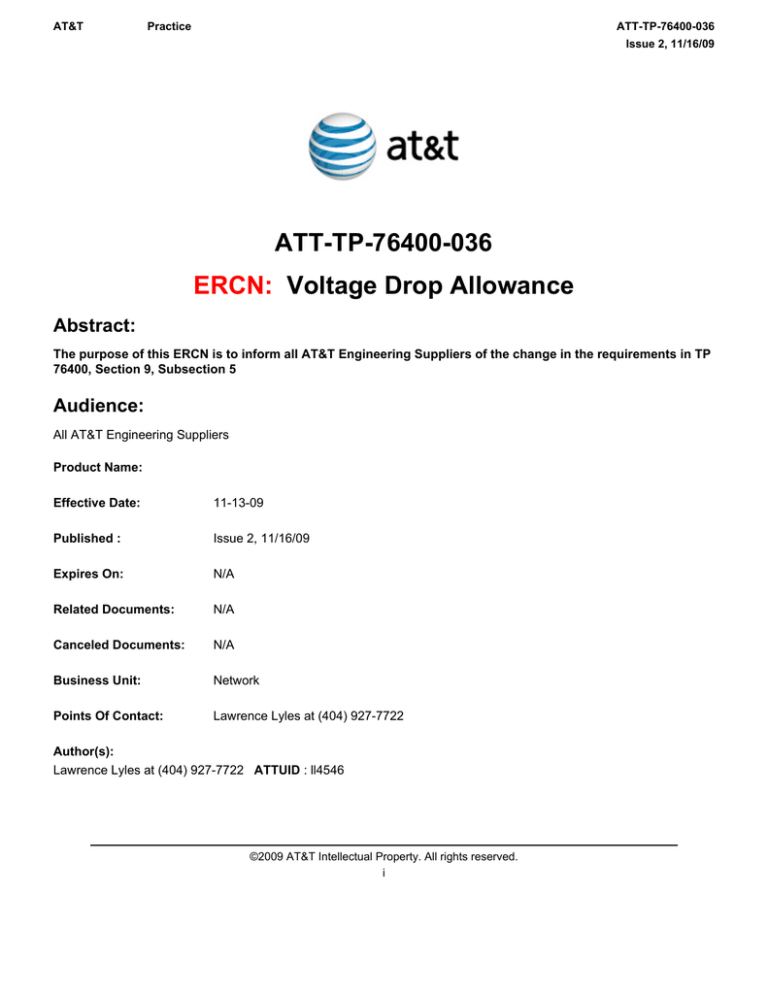
AT&T
Practice
ATT-TP-76400-036
Issue 2, 11/16/09
ATT-TP-76400-036
ERCN: Voltage Drop Allowance
Abstract:
The purpose of this ERCN is to inform all AT&T Engineering Suppliers of the change in the requirements in TP
76400, Section 9, Subsection 5
Audience:
All AT&T Engineering Suppliers
Product Name:
Effective Date:
11-13-09
Published :
Issue 2, 11/16/09
Expires On:
N/A
Related Documents:
N/A
Canceled Documents:
N/A
Business Unit:
Network
Points Of Contact:
Lawrence Lyles at (404) 927-7722
Author(s):
Lawrence Lyles at (404) 927-7722 ATTUID : ll4546
©2009 AT&T Intellectual Property. All rights reserved.
i
AT&T
Practice
ATT-TP-76400-036
Issue 2, 11/16/09
Table Of Contents
Reason For Current Issue
1.
2.
Introduction
TP 76400, Section 12 Subsection 6 DC Power Distribution
Revision Log
©2009 AT&T Intellectual Property. All rights reserved.
ii
1
1
2
AT&T
Practice
ATT-TP-76400-036
Issue 2, 11/16/09
Reason For Current Issue
Issue Number
Date
Description
2
11/16/09
Published By
ll4546
1. Introduction
The requirements of6.2.1 have been modified as indicated in Section12
2. TP 76400, Section 12 Subsection 6 DC Power Distribution
Prior to Change:
6.2.1 The maximum allowable one way voltage drop from batteries to the served equipment via a BDFB/SPDU shall be
1.0 volt for standard configuration offices with an equipment end-voltage of 42.6V DC per reference drawing ATT-P-05410E..
Post Change:
6.2.1 The maximum allowable one way voltage drop from batteries to the served equipment shall be determined by the
type of site, power plant, and equipment end-voltage:
a) Standard configuration offices with an equipment end-voltage of 42.6V DC or equipment loads served by single power
plants in other AT&T inside plant sites shall have up to a maximum 1 volt, 1-way voltage drop as follows: .25V, 1-way
maximum allowance from the batteries to the power plant; .5V, 1-way maximum primary power cabling voltage drop from
the power board to the BDFB or SPDU; minimum .25V, 1-way secondary power cabling voltage drop from the BDFB or
SPDU to the equipment bay fuse panel or equipment load per reference drawing ATT-P-05410-E.
b) Sites with dual power plants that serve equipment exclusively with an equipment 40V or lower end-voltage shall have
up to a maximum 1.75 volt, 1-way voltage drop as follows: .25V, 1-way maximum allowance from the batteries to the
power plant; 1V, 1-way maximum primary power cabling voltage drop from the power board to the BDFB; minimum .5V,
1-way secondary power cabling voltage drop from the BDFB or SPDU to the equipment bay fuse panel or equipment
load. Dual power plants engineered with a voltage drop design for 40V end-voltage equipment cannot be used to support
equipment with a higher end-voltage, e.g., 42V.
The .25V, 1-way voltage drop from the batteries to the power plant is an established value to make up for losses in drops
from the top of the bay to the equipment; 1-way voltage drop under the maximum allowed for the primary power cabling
from the power board to the BDFB or SPDU may be added to and used with the secondary power cabling voltage drop
allowance from the BDFB or SPDU to the equipment, not to exceed the overall 1-way voltage drop requirement:
2009 AT&T Intellectual Property. All rights reserved.
1
AT&T
Practice
ATT-TP-76400-036
Issue 2, 11/16/09
Questions relative to this ERCN should be addressed to Lawrence Lyles at (404) 927-7722..
Lawrence E. Lyles
Lead Network Engineering Manager
Common System Support
Concurred
Name/Title
Date
X
Crissy Holmes- Senior Engineering Manager-Network Quality, Southwest
11-05-09
X
Al Bergman- Lead Network Engineering Manager - Common System
11-04-09
Release Approved
X
Lawrence E. Lyles - Lead Network Engineering Manager
Revision Log
Issue Number
Date
Description
2
11/16/09
2009 AT&T Intellectual Property. All rights reserved.
2
Published By
ll4546
11-09-09


